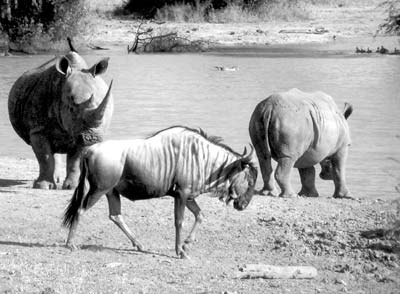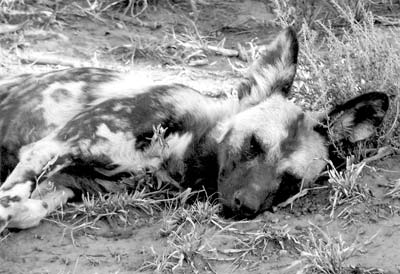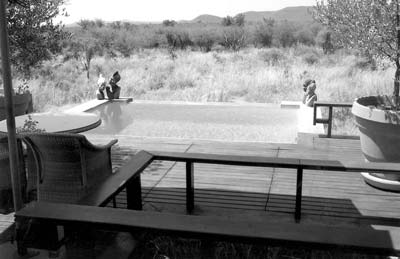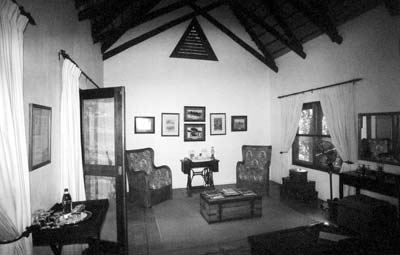Luxury adventure travel in South Africa
(First of three parts, jump to part 1, part 2, part 3)
South African game reserves
Everything you ever wanted to know about South African game reserves but didn’t know what to ask!
Imagine that your very large, fenced-in backyard had wild animals in it. You could keep track of the animals, and you could increase their numbers or variety. You could also “cull” them or move them to other backyards. (Culling is currently a very controversial topic. At the beginning of the 20th century, due to heavy poaching for ivory, there were only some 50 wild elephants in all of South Africa! Presently, in Kruger National Park alone, there are some 17,000 elephants — a level of crowding that is said to be unsustainable.)
In your hypothetical backyard reserve, the animals would be free to behave naturally, you would not have to feed them or provide any shelter, and they could move around as they pleased. The wildest and shiest of animals gradually would get accustomed to nonthreatening humans, which would make this a popular location for soft-adventure travel.
Now imagine that your fenced-in backyard reserve is called Kruger National Park and is the size of Massachusetts!
Kruger National Park, in the northeast quadrant of South Africa, was established around 1900 when it was realized that mosquitoes and the tsetse fly made farming and other settlement impractical. Wild animals were thriving, however, and hunters began to decimate their numbers until the park was established.
In subsequent decades the remaining farmers on property adjacent to the park gave up on agriculture, tore down their fences and, while retaining rights to their property boundaries, developed privately owned game reserves and joined the, now, prosperous industry of wild-animal-viewing tourism. These private reserves can take their guests only within their original property boundaries.
This total, tremendous reserve area boasts some 147 mammal species, 500 bird species and similarly large numbers of reptile, amphibian and fish species. All animals here are free to roam to the limits of the remote park fence lines but are generally quite territorial and tend to stay in their home areas, which allows the private reserve owners to keep track of their herds almost as well as if they had maintained their original fencing networks.
In Kruger National Park, one can drive in by private car, take bus tours, camp or stay in a variety of accommodations, from modest to luxury. Visitors cannot stray from roadways; however, the “big five” (for hunters, Africa’s most dangerous animals) — elephant, lion, leopard, rhino and buffalo — usually can be spotted on a visit of several days.
Private game reserves
In private reserves, accommodations often are very luxurious, with meals and other services to match. All-inclusive costs can run $500 to $800 (and up) per person, double occupancy, per night.
The very best time to go is at the end of the dry season, August to early October, when mosquito (and malaria) problems are less prevalent and animals tend to visit water holes. Thinner vegetation helps in animal spotting. In March 2005, I visited (and with three other travel journalists, was a guest of) two of South Africa’s most luxurious safari lodges.
Mateya Safari Lodge
Mateya Safari Lodge (Madikwe Game Reserve, Derdepoort, North-West, South Africa; phone +27 14 778-9200, fax +27 14 1778 9201, e-mail info@mateyasafari.com or visit www.mateyasafari.com) is located in the mosquito-free Madikwe Game Reserve in the north of the country next to the Botswana border. It provides, in my opinion, over-the-top luxurious accommodation in addition to great game drives in this resource-rich area.
Their daily rate of $822 per person, double, includes gourmet meals and viewing of the “super seven”: the buffalo, cheetah, elephant, leopard, lion, rhino (both black and white) and the very rarely seen African wild dog.
The bedroom in my secluded “cottage,” one of only five, was handsome and large. At day’s end, before the gourmet dinner (their wine cellar has 8,000 bottles), I had the difficult choice of soaking in a long, deep tub in a room as big as my living room at home or using the indoor or the outdoor shower before taking a brief plunge in my cottage’s private swimming pool. (This is dirty work, of course, but someone has to do it.)
Everywhere I looked, in my cottage and in the public spaces, there were fantastic examples of African art and artifacts — a combination of quality and quantity I have never seen.
A water hole has been established a couple of hundred yards from the wide deck at the main building. I watched a near-continuous parade of thirsty animals casually drinking and leaving. A powerful telescope on the deck made viewing very up-close and personal.
Punch up Mateya’s website for complete contact information and for dramatic views of their facilities and typical game viewing photos.
Sabi Sabi
Sabi Sabi (P.O. Box 52665, Saxonwold, 2132, South Africa; phone [+27-11] 483 3939, fax [+27-11] 483 3799, e-mail res@sabisabi.com or visit www.sabisabi.com), a luxury private game lodge, is in the middle of the Sabi Sands Game Preserve, perhaps the richest wild game area in South Africa. Sabi Sabi has three lodges on its property, each with a different theme.
Bush Lodge, with 25 suites, has a contemporary African theme. Selati Camp is a re-creation of 19th-century gold-field camps. Eight lantern-lit suites provide a unique atmosphere. Earth Lodge, noted by Condé Nast Traveler as one of the world’s top 52 hot spots, has 13 exclusive luxury suites that seem to grow out of the earth.
Unlike some lodges, Sabi Sabi is not fenced off from the bush. I saw an impala and her baby in the middle of some lush landscaping enjoying a midday snack. Most large animals, with the exception of elephants, have been known to wander about on lodge grounds at night; after dark, guests are escorted to their cabins and are advised to stay indoors until morning.
I spent two nights in Bush Lodge. The routine there is similar to that at most other private lodges. Since the animals are least active during the middle of the day, game drives are scheduled for early morning and early evening. Around 6 a.m. a snack is served and guests are off in 4-wheel-drive vehicles. On a stool hanging off the front of the vehicle, a tracker sits watching for signs of game, leaving the driver free to concentrate on his job. If an animal is spotted in the bush, the driver will turn off the road and follow slowly, attempting to get closer.
Interestingly enough, many animals prefer the open roads over the brushy landscape. One morning a lone hyena padded down the center of the sandy road toward our slow-moving vehicle. When it became apparent that one of us would have to give way, the hyena casually moved about three feet into the bush and then moved back on the road without slowing down and with only a curious glance at us as we moved by.
After a late breakfast, it’s time for leisure at the lodge. The late-afternoon game drive goes on well into the evening, with a powerful spotlight sweeping the bush to spot nocturnal denizens. A bit after night has fallen, a brief stop is made for a traditional “sundowner,” with a compartment opened in the back of the vehicle to provide the drinks and snacks.
Sabi Sabi high-season rates range from $650 to $1,675 per person, double. Information is available on their colorful, comprehensive website.
Happy trails!




